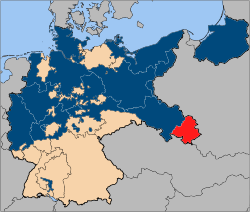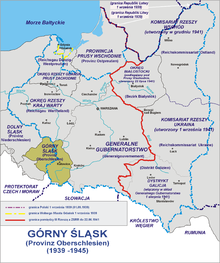- Upper Silesia Province
-
Oberschlesien
Upper SilesiaProvince of Prussia ← 
1919 — 1938
1941 — 1945 →
→
 →
→
 →
→

Flag Coat of arms Upper Silesia (red), within the Free State of Prussia Capital Oppeln (1919—1938)
Kattowitz (since 1941)History - Established 1919 - Merged with L. Silesia 1938 - 1941 - Disestablished 1945 Area - 1925 9,702 km2 (3,746 sq mi) Population - 1925 1,379,408 Density 142.2 /km2 (368.2 /sq mi) Political subdivisions Kattowitz
OppelnThe Province of Upper Silesia (German: Provinz Oberschlesien; Silesian German: Provinz Oberschläsing; Polish: Górny Śląsk; Silesian: Gůrny Ślůnsk) was a province of the Free State of Prussia created in the aftermath of World War I. It comprised much of the region of Upper Silesia and was eventually divided into two administrative regions (Regierungsbezirke), Kattowitz and Oppeln. The provincial capital was Oppeln (1919—1938) and Kattowitz (since 1941), while other major towns included Beuthen, Gleiwitz, Hindenburg O.S., Neiße and Ratibor.
Contents
History
Weimar Republic
Within Weimar Germany, the Prussian Province of Silesia was divided into the provinces of Upper Silesia and Lower Silesia in 1919 in the aftermath of World War I. Silesian Uprisings of Poles against Germans occurred in Upper Silesia from 1919 and 1920. Uproar over the Upper Silesia plebiscite of 1921 led to a third uprising, which culminated in the Battle of Annaberg. According to the German-Polish Accord on East Silesia,[1] signed in Geneva on May 15, 1922 the eastern Upper Silesian lands were transferred from Germany to the Second Polish Republic on June 20 and became part of the Autonomous Silesian Voivodeship. The territory remaining in Prussian Upper Silesia was administered within Regierungsbezirk Oppeln and - according to Polish sources - had 530,000 Poles within it. [2]
Nazi Germany
After the Nazis' takeover in Germany the German-Polish Accord on East Silesia was signed. Among other stipulations, according to the treaty each contractual party guaranteed in its respective part of Upper Silesia equal civil rights for all the inhabitants. The German Upper Silesian Franz Bernheim succeeded in convincing the League of Nations to force Nazi Germany to abide by the Accord.[3] Accordingly in September 1933 the Reich's Nazi government suspended in Upper Silesia all anti-Semitic discrimination laws already imposed and excepted the province from all new such future decrees, until the Accord expired in May 1937.[4]
The Province of Upper Silesia was joined to Lower Silesia to form the Province of Silesia in 1938.
World War II
After the invasion of Poland in 1939, Polish Upper Silesia, including the Polish industrial city of Kattowitz, was directly annexed into the Province of Silesia. This annexed territory, also known as East Upper Silesia (Ostoberschlesien), became part of the new Regierungsbezirk Kattowitz.
German occupation forces began a policy of repression against the Polish population of eastern Upper Silesia, which started as early as September 1939[5] based on lists made before the war that pointed out Poles active in social and political life.[5] A second wave of arrests happened during October and November in Intelligenzaktion Schlesien, aimed against Polish intellectuals, many of whom perished prison camps. A third wave of arrests came on in April and May 1940 during the AB Aktion.
In Katowice, according to the historian Czesław Madajczyk, one of the harshests centres of oppression was the prison on Mikołowska street where people were reported to be murdered by Germans through the use of guillotine.[5] A prison and penal camp were also established in the region in which Polish activists from Upper Silesia were held.[5]
At the same time, the Polish population was expelled from eastern Upper Silesia; from 1939 till 1942 40.000 Poles were expelled.[6] In their place ethnic Germans from Volhynia and the Baltic countries were settled in Upper Silesia's urban areas. Until 1943 about 230,000 ethnic Germans were located on the Polish territories of eastern Upper Silesia and the Wartheland.[7][8] The death toll of Polish population in Upper Silesia at the hands of Germans is within 25,000 victims, with 20,000 of them being from urban population.[5]
In 1941, the Province of Silesia was again divided into the Provinces of Upper and Lower Silesia; Kattowitz (Katowice, in the former Autonomous Silesian Voivodeship of pre-war Poland) was made the capital of Upper Silesia instead of the smaller town of Oppeln.
The German province of Upper Silesia was conquered by the Soviet Red Army from February until the end of March 1945 during World War II's Lower and Upper Silesian Offensives. The post-war Potsdam Agreement granted the entire province's territory to the People's Republic of Poland; the territory is now in the Polish Opole and Silesian Voivodeships. Most Germans remaining in the territory were expelled westward. The Landsmannschaft Schlesien represents German Silesians from Upper and Lower Silesia. Near and in Opole, a German minority remains.
Administrative regions
As of January 1, 1945
Regierungsbezirk Kattowitz
Urban districts / Stadtkreise
- City of Beuthen
- City of Gleiwitz
- City of Hindenburg in Oberschlesien
- City of Kattowitz
- City of Königshütte
Rural districts / Landkreise
- Landkreis Bendsburg
- Landkreis Beuthen-Tarnowitz
- Landkreis Bielitz
- Landkreis Kattowitz
- Landkreis Krenau
- Landkreis Ilkenau
- Landkreis Pless
- Landkreis Rybnik
- Landkreis Saybusch
- Landkreis Teschen
- Landkreis Tost-Gleiwitz
Regierungsbezirk Oppeln
Urban districts / Stadtkreise
- City of Nysa/Neisse
- City of Opole/Oppeln
- City of Racibórz/Ratibor
Rural districts / Landkreise
- Landkreis Blachstädt
- Landkreis Cosel
- Landkreis Falkenberg in Oberschleisen
- Landkreis Gross Strehlitz
- Landkreis Grottkau
- Landkreis Guttentag
- Landkreis Kreuzburg in Oberschlesien
- Landkreis Leobschütz
- Landkreis Lublinitz
- Landkreis Neisse
- Landkreis Neustadt in Oberschlesien
- Landkreis Oppeln
- Landkreis Ratibor
- Landkreis Rosenberg
- Landkreis Warthenau
References
- ^ Cf. Deutsch-polnisches Abkommen über Ostschlesien (Genfer Abkommen)
- ^ Nowa Encyklopedia Powszechna PWNPaństwowe Wydawnictwo Naukowe=Warszawa 2004 pages 117-118 volume 8
- ^ Cf. Bernheim-Petition
- ^ * Cf. Philipp Graf, Die Bernheim-Petition 1933: Jüdische Politik in der Zwischenkriegszeit, Vandenhoeck & Ruprecht, Göttingen 2008, (Schriften des Simon-Dubnow-Instituts; 10), 342 pp., ISBN 978-3-525-36988-3.
- ^ a b c d e Czesław Madajczyk "Polityka III Rzeszy w okupowanej Polsce" Państwowe Wydawnictwo Naukowe, Warszawa 1970 volume 1, page 384
- ^ Czesław Madajczyk "Polityka III Rzeszy w okupowanej Polsce" Państwowe Wydawnictwo Naukowe, Warszawa, volume 1 pages 424-426
- ^ Czesław Madajczyk "Polityka III Rzeszy w okupowanej Polsce" Państwowe Wydawnictwo Naukowe, Warszawa, volume 1 page 352
- ^ Czesław Madajczyk "Polityka III Rzeszy w okupowanej Polsce" Państwowe Wydawnictwo Naukowe, Warszawa, volume 1 page 249
External links
- Volksabstimmungen 1920 und 1922 (German)
Silesia topics History Symbols Coats of arms · Flags · Unofficial Anthems: Schlesien Unvergessene Heimat · Schlesierlied · Slezská hymnaEconomy Tourism · Upper Silesian Coal Basin (with: Upper Silesian Industrial Region · Rybnik Coal Area · Ostrava-Karviná Coal Area) · Lower Silesian Coal Basin · Legnicko-Głogowski Okręg Miedziowy · Bielski Okręg Przemysłowy · Silesian metropolitan area · Katowice urban areaCuisine Silesian dumplings · Black noodles · Makówki · Siemieniotka · Żur śląski · Wodzionka · Szałot · Kreple · Kołocz · Galert · Krupniok · Karminadle · Bryja · Moczka · Modra kapusta · Ciapkapusta · HauskyjzaLanguages Silesian (Cieszyn Silesian dialect · Lach Silesian dialect · Niemodlin Silesian dialect · Bytom Silesian dialect · Jabłonków Silesian dialect · Namysłów Silesian dialect · Prudnik Silesian dialect · Opole Silesian dialect · Syców Silesian dialect · Lower Silesian dialect · Sulkovian Silesian dialect · Texas Silesian) · German · Polish · Czech · Lower SilesianAdministrative
divisionsFormerDuchies (Piasts · Dukes) · Silesian Voivodeship (1920–1939) (Parliament · Treasury · Politicians) · State country · Province of Silesia / Upper Silesia / Lower Silesia · Sudetenland · New Silesia · Austrian Silesia · Eastern SilesiaPresentSilesian · Opole · Lower Silesian · Lubusz Voivodeships · Silesian-Moravian Region · Jeseník District · part of Saxony and Brandenburg (mainly in Niederschlesischer Oberlausitzkreis/Görlitz (district))Geography MountainsRiversLakesHighlands
Lowlands
OtherSilesian Highlands · Silesian Lowlands · Silesian-Lusatian Lowlands · Silesian Foothills · Silesian-Moravian Foothills · Oświęcim Valley · Ostrava Valley · Jelenia Góra valley · Kłodzko Valley · Zielona Góra Acclivity · Wał Trzebnicki · Przedgórze Sudeckie · Obniżenie Milicko-Głogowskie · Silesia Walls · Lower Silesian Wilderness · Silesian PrzesiekaOther Silesians · Silesian regional costumes (Śląskie stroje ludowe) · Silesian Autonomy Movement · Landsmannschaft Schlesien · Silesian architecture · Silesia national football team · Silesian Stadium · Silesian Football Association · Silesian-Moravian Football League · Silesian (European Parliament constituency) · Lower Silesian and Opole (European Parliament constituency) · Evangelical Church of Berlin-Brandenburg-Silesian Upper Lusatia · Silesian Evangelical Church of Augsburg Confession · FamilokWikiProject Silesia · Portal Categories:- States and territories established in 1919
- States and territories disestablished in 1945
- Geography of Silesia
- History of Silesia
- Provinces of Prussia
Wikimedia Foundation. 2010.


